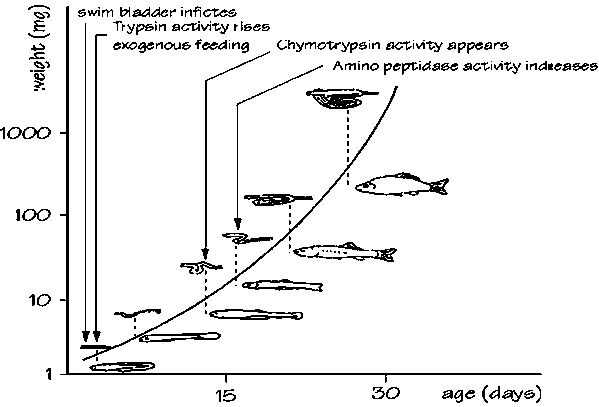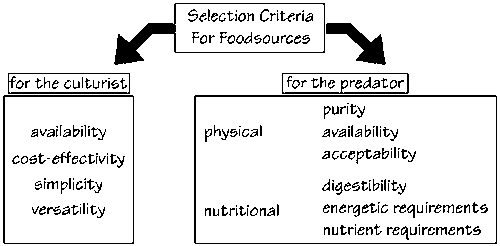Patrick Lavens and Patrick Sorgeloos
Laboratory of Aquaculture & Artemia Reference
Center
University of Gent, Belgium
Whereas in the 1970s the production of farmed marine finfish and shrimp relied almost exclusively on the capture of wild fry for subsequent stocking and on-growing in ponds, tanks or cages, the complete domestication of many marine and brackishwater aquaculture species was only achieved during the last two decades. However, since then the controlled production of larvae from captive broodstock, or in other words the hatchery production of fry, has now become a routine operation for most cultivated fish and shellfish species; billions of fish and shellfish larvae (i.e. bivalve molluscs, penaeid shrimp, salmonids, European seabass, Gilthead seabream etc.) currently being produced within hatcheries all over the world.
The cultivation of larvae is generally carried out under controlled hatchery conditions and usually requires specific culture techniques which are normally different from conventional nursery and grow-out procedures, and especially with respect to husbandry techniques, feeding strategies, and microbial control. The main reason for this is that the developing larvae are usually very small, extremely fragile, and generally not physiologically fully developed. For example, their small size (ie. small mouth size), the uncompleted development of their perception organs (ie. eyes, chemoreceptors) and digestive system, are limiting factors in proper feed selection and use during the early first-feeding or start-feeding period. Moreover, in species such as shrimp, these are not the only problems as the developing larvae also have to pass through different larval stages, eventually changing from a herbivorous filter feeding behaviour to a carnivorous hunting behaviour. It is perhaps not surprising therefore that larval nutrition, and in particular that of the sensitive first-feeding larvae, has become one of the major bottlenecks preventing the full commercialization of many farmed fish and shellfish species. This can also be illustrated by the following examples.
· Larval/mouth size at first-feeding
The mouth size of first-feeding larvae usually mechanically restricts the size of the food particles which can be ingested. In general, mouth size is correlated with body size, which in turn is influenced by egg diameter and the period of endogenous feeding (ie. yolk sac consumption period). For example, Atlantic salmon eggs are usually at least four times larger than Gilthead seabream eggs (Table 1.1), and consequently on hatching yield large salmon larvae with large yolk sac supplies (ie. sufficient endogenous feed reserves for the first three weeks of their development), whereas first-feeding Gilthead seabream larvae are very small with limited yolk sac reserves, and consequently can only feed endogenously for about three days (Figures 1.1, 1.2 and 1.3). For example, at first-feeding salmonid ‘alevins’ are able to consume feed particles as large as 1 mm, compared with only 0.1 mm in the case of first-feeding Gilthead seabream larvae.
Table 1.1. Size of eggs and larval length at hatching in different fish species (modified from Jones and Houde, 1981).
|
Species |
Egg diameter |
Length of larvae |
|
Atlantic salmon (Salmo salar) |
5.0 - 6.0 |
15.0 - 25.0 |
|
Rainbow trout (Oncorhynchus mykiss) |
4.0 |
12.0 - 20.0 |
|
Common carp (Cyprinus carpio) |
0.9 - 1.6 |
4.8 - 6.2 |
|
European sea bass (Dicentrarchus labrax) |
1.2 - 1.4 |
7.0 - 8.0 |
|
Gilthead seabream (Sparus aurata) |
0.9 - 1.1 |
3.5 - 4.0 |
|
Turbot (Scophthalmus maximus) |
0.9 - 1.2 |
2.7 - 3.0 |
|
Sole (Solea solea) |
1.0 - 1.4 |
3.2 - 3.7 |
|
Milkfish (Chanos chanos) |
1.1 - 1.25 |
3.2 - 3.4 |
|
Grey mullet (Mugil cephalus) |
0.9 - 1.0 |
1.4 - 2.4 |
|
Greasy grouper (Epinephelus tauvina) |
0.77 - 0.90 |
1.4 - 2.4 |
|
Bream (Acanthopagrus cuvieri) |
0.78 - 0.84 |
1.8 - 2.0 |
Figure 1.2. Gilthead seabream larva with yolk sac.
Figure 1.3. Atlantic salmon and gilthead seabream larvae at first feeding.
· Functional digestive tract
The developmental status of the digestive system of first-feeding larvae also dictates the possibility or not of the larvae to digest the food ingested. For example, first-feeding salmon alevins already have a well developed digestive tract with functioning enzyme systems which allow the digestion of feed crumbles on first-feeding. By contrast, Gilthead seabream larvae (like many other fish larvae; Figure 1.4) do not have a functional stomach, but only a short digestive tract with only a few functional enzyme systems at the onset of first-feeding. It follows therefore that these fish larvae will have to rely on a food source that: 1) is at least partially and easily digestible (ie. the feed should contain large amounts of free amino acids and oligopeptides instead of indigestible complex protein molecules), 2) contains enzyme systems which allow autolysis (ie. self destruction of the food particle), and 3) supplies in abundance all the essential nutrients required by the larval predator.
Figure 1.4. Ontogenetic development of the digestive tract in cyprinid type fish (i.e. common carp; modified from Dabrowski, 1984).

However, formulated feeds do not generally meet all these requirements and usually result in poor growth and survival in small fish larvae such as the Gilthead seabream. On the otherhand live food organisms seem to meet all the necessary criteria for these small larvae. However, for food to be ingested by a larva it first has to be detected, and so the degree of development of the functional sense organs such as the optical receptors (eyes), chemoreceptors (olfactory organs, tastebuds) and mechanoreceptors (lateral line) is crucial. For example, the eyes of fish larvae usually only contain cones in the retina resulting in poor visibility, whereas the eyes of juvenile fish also contain rods with more visual pigments in the retina. Moreover, live food organisms usually have a much better contrast than artificial feeds and generally have a triggering effect by their continuous movement, allowing an enhanced perception by the feeding larva. Similarly, the swimming activity of live food organisms generally assures a good distribution of food items in the water column, this in turn facilitating more frequent encounters with the developing larvae which in most cases have a low mobility.
The aim of the present manual is to describe the various techniques employed for the production and application of live food organisms as well as their application in larviculture. The natural diet of most cultured fish and shellfish species consists of a wide diversity of phytoplankton species (diatoms, flagellates, etc.) and zooplankton organisms (copepods, cladocerans, decapod larvae, rotifers, ciliates, etc.), found in great abundance in the natural plankton. This abundance and maximal diversity of food organisms of different sizes and nutritional composition provide maximal chances for meeting all the requirements of the predator larvae. Although the collection and/or production of natural plankton for feeding in commercial hatcheries may therefore appear evident, in practice the use of natural plankton often entails many constraints which will be explained in detail in chapter 5. For the industrial larviculture of fish and shellfish, readily and consistently available, practical and performing live diets need to be selected.
The selection of a suitable and nutritious diet should be based on a number of criteria (Fig. 1.5.). Most of the criteria as identified from the viewpoint of the larva have already been discussed above with the exception of the criterion ‘purity’. One should not only consider the impurities by alien particles, but also the hygienic condition of the diet. Contamination of live food with bacteria is not necessarily hazardous but may have a tremendous impact on the microbial populations in the associated culture medium and eventually in the fish/shrimp’s gut flora, and consequently on the health status and the digestive capability of the larva (i.e. an impact that has only been fully realized in recent years; see also chapters 3, 4.3 and 4.4).
Figure 1.5. Selection criteria for larval food sources from the viewpoint of the culturist and the cultured larva (modified from Léger et al., 1987).

From the practical viewpoint of the culturist, a good diet should be readily available, cost-effective, simple as well as versatile in application. The consistent availability of sufficient quantities of food organisms is of the utmost importance in continuous hatchery productions. In this respect, the collection and feeding of wild plankton has proven unreliable and not always practical (see also chapter 5).
Over the past decades, trial and error approaches have resulted in the adoption of selected larviculture diets, taking into account the different criteria listed in Fig. 1.5. Today, three groups of live diets are widely applied in industrial larviculture of fish and shellfish:
· different species of 2 to 20 µm microalgae for:bivalves
penaeid shrimp
rotifers, copepods,...
fish
· the 50 to 200 µm rotifer Brachionus plicatilis for:
crustaceans
marine fish
· the 400 to 800 µm brine shrimp Artemia spp. (meta-)nauplii for:
crustaceans
fish
Apart from these main groups, a few other live feeds are used on a more limited scale for specific larviculture practices, including Brachionus rubens, Moina spp., daphnids, and decapsulated brine shrimp cysts for freshwater fish and prawn larvae, and Artemia biomass for lobster larvae, shrimp postlarvae and broodstock, and marine fish juveniles. In recent years various formulations of supplementation and substitution products have been added to this list although replacement diets are becoming more and more successful in shrimp larviculture. However, their use in first-feeding marine fish is still very limited.
Finally, a selection criterion that also needs to be addressed, especially at competitive market prices of hatchery fry (for example, European seabass and gilthead seabream prices have decreased by more than 50% over the last few years) is the larval feed cost, which, depending on the species and culture technique applied, may account for up to 15% of the total production cost. Optimization of live food production and use in hatcheries has therefore become even more important. This issue will also be further elaborated in the different chapters of this manual.
Literature cited
Dabrowski, K., 1984. Ontogenetic development of cyprinid-like type of digestive tract. Reprod. Nutr. Develop. 24: 807-819
Jones, A. and Houde E.D., 1981. Mass rearing of fish fry for aquaculture, p.351-374. In: realism in aquaculture: achievements, constraints, perspectives. Bilio, M., Rosenthal, H. and Sinderman, G.J. (eds). European Aquaculture Society, Bredene, Belgium, 585 p.
Leger, P., Bengston, D.A., Sorgeloos, P.,Simpson, K.L. and Beck, A.D., 1987. The nutritional value of Artemia: a review, p. 357-372. In: Artemia research and its applications. Vol. 3. Sorgeloos, P., Bengtson, D.A., Decleir, W., Jaspers, (eds). Universa Press, Wetteren, Belgium, 556 p.